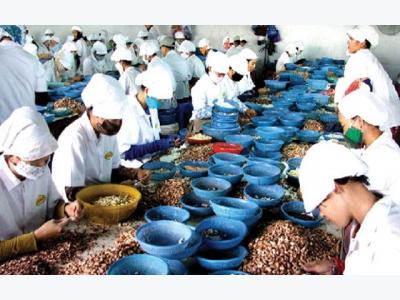Export markets nuts about Vietnams cashews

Vietnam exported 26,000 tonnes of cashew nuts worth US$232 million in the first two months of 2017, according to the Vietnam Cashew Association (Vinacas). Despite a decrease of 26.2 percent in volume and 12 percent in value compared with the same period last year, exports to some markets grew strongly, inspiring the sector’s further efforts to boost sales to foreign markets.
Good growth
Vietnamese raw cashew prices currently fluctuate around VND50,000-60,000 per kg, depending on quality.
The US, China and the Netherlands continue to be the top three importers of Vietnamese cashew, respectively accounting for 34.9 percent, 18.9 percent, and 11.8 percent of total export value of this product. In January, exports to Australia grew 75.1 percent, the UK 57.8 percent, and the United Arab Emirates 5.2 percent.
Vietnam expects to export 360,000 tonnes of cashew nuts worth about US$3 billion this year.
Low crop yield
Although Vietnam is the world’s largest cashew producer and exporter, domestic raw cashew output only meets about 30 percent of the demand of more than 300 processing facilities. Global consumer demand for cashew nuts has grown about 10 percent annually, while domestic cashew output has grown just five percent. Cashew businesses have encountered numerous difficulties due to material shortages.
Vinacas initially predicted that 2017’s raw cashew output would reach about 550,000 tonnes, and Vietnam would have to import an additional 1.1 million tonnes to have 1.55 million for processing facilities to produce 360,000 tonnes of cashew nuts for export. However, due to unfavorable weather, Vinacas recently predicted that annual raw cashew output would reach around 300,000 tonnes, a decline of 40 percent compared with 2016. This will require the import of 1.3 million tonnes of raw cashews, 200,000 tonnes more than initially predicted.
Heavy dependence on imported materials has hindered cashew processing facilities’ efforts to ensure product quality, making it difficult for them to attract orders.
As planned by the Ministry of Agriculture and Rural Development, Vietnam will have 300,000ha of cashew by 2020, an increase of 5,000ha compared with the present.
In the opinion of Dr. Nguyen Nhu Hien, Deputy Director of the Industrial Crops and Fruit Trees Division of the Department of Crops Production, tighter linkages between businesses and farmers are crucial to the sustainable development of the cashew sector. Localities which enjoy favorable weather and soil conditions for cashew planting, such as Binh Phuoc, Dong Nai and Gia Lai, should prepare specific plans for each planting area. These localities should cooperate with businesses to assist cashew farmers in applying intensive cultivation techniques to enhance yields and quality. “We expect to increase cashew yields to about two tonnes per hectare in the near future,” Dr. Hien said.
The Ministry of Agriculture and Rural Development highlighted the necessity of reorganizing cashew production to enhance yields, applying new technologies in processing, and increasing the linkages between processing facilities and farmers.
Có thể bạn quan tâm
 New agency targets effective food quality controls
New agency targets effective food quality controls In addition, we will reform the administrative procedures to make it easier for businesses and individuals to obtain food safety and hygiene certification.
 Local fresh produce losing market share to Thailand
Local fresh produce losing market share to Thailand Hanoi Supermarket Association chair Vu Vinh Phu told stakeholders at a recent business conference that Vietnamese consumers have lost confidence in home
 Embattled Vietnam agriculture loses market share on home turf
Embattled Vietnam agriculture loses market share on home turf Vietnamese agriculture, battling to retain confidence among consumers, is losing market share across the agriculture and food spectrum, once considered